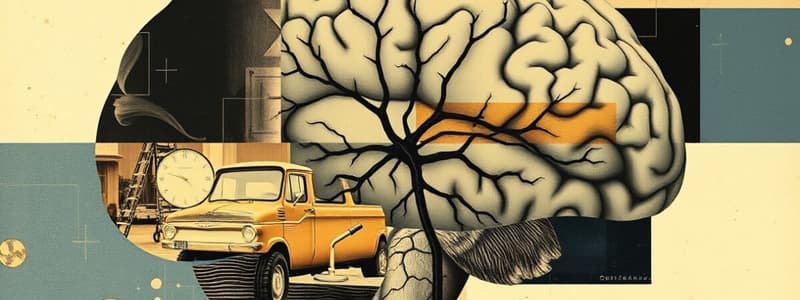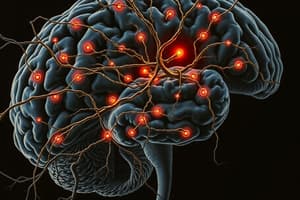Podcast
Questions and Answers
Which neurotransmitter is primarily associated with mood regulation?
Which neurotransmitter is primarily associated with mood regulation?
- Acetylcholine
- Dopamine
- Serotonin (correct)
- Norepinephrine
The pia mater is the tough outer layer of the meninges.
The pia mater is the tough outer layer of the meninges.
False (B)
What is the primary function of cerebrospinal fluid (CSF)?
What is the primary function of cerebrospinal fluid (CSF)?
To cushion and protect the brain and spinal cord.
Dopamine is involved in _____ and reward.
Dopamine is involved in _____ and reward.
Which of the following layers of the meninges is known for containing cerebrospinal fluid?
Which of the following layers of the meninges is known for containing cerebrospinal fluid?
Match the anatomical terms with their meanings:
Match the anatomical terms with their meanings:
The ____ mater is the delicate inner layer adhering to the brain.
The ____ mater is the delicate inner layer adhering to the brain.
Acetylcholine is primarily involved in reward pathways in the brain.
Acetylcholine is primarily involved in reward pathways in the brain.
Which term describes body parts that are further from the trunk?
Which term describes body parts that are further from the trunk?
What is the primary function of the frontal lobe?
What is the primary function of the frontal lobe?
The parasympathetic nervous system is responsible for the 'fight or flight' response.
The parasympathetic nervous system is responsible for the 'fight or flight' response.
What are the two main categories of the nervous system?
What are the two main categories of the nervous system?
The _________ is responsible for coordination and balance.
The _________ is responsible for coordination and balance.
Match the following glial cell types with their functions:
Match the following glial cell types with their functions:
Which part of the brain is primarily involved in vision processing?
Which part of the brain is primarily involved in vision processing?
The axon transmits signals toward the cell body.
The axon transmits signals toward the cell body.
What does the Circle of Willis ensure?
What does the Circle of Willis ensure?
The _________ nervous system controls voluntary movements.
The _________ nervous system controls voluntary movements.
Flashcards are hidden until you start studying
Study Notes
Central Nervous System (CNS)
-
Brain
- Divided into four main lobes:
- Frontal: executive functions, decision-making, motor control.
- Parietal: sensory perception, spatial awareness.
- Temporal: auditory processing, memory, language.
- Occipital: vision processing.
- Cerebellum: coordination, balance, fine motor skills.
- Brainstem: regulates vital functions (heart rate, breathing); connects brain to spinal cord.
- Divided into four main lobes:
-
Spinal Cord
- Transmits signals between the brain and the body.
- Composed of segments (cervical, thoracic, lumbar, sacral).
- Contains gray matter (neurons) and white matter (myelinated axons).
Peripheral Nervous System (PNS)
- Somatic Nervous System: controls voluntary movements and sensory information.
- Autonomic Nervous System: regulates involuntary functions.
- Divided into:
- Sympathetic: "fight or flight" response.
- Parasympathetic: "rest and digest" response.
- Divided into:
Neurons
- Basic unit of the nervous system.
- Composed of:
- Cell Body: contains nucleus and organelles.
- Dendrites: receive signals from other neurons.
- Axon: transmits signals away from the cell body.
- Myelin Sheath: insulates axon, speeds up signal transmission.
- Synapse: junction between neurons where neurotransmitter release occurs.
Glial Cells
- Supportive cells in the nervous system.
- Types include:
- Astrocytes: maintain blood-brain barrier, regulate blood flow.
- Oligodendrocytes: produce myelin in CNS.
- Schwann Cells: produce myelin in PNS.
- Microglia: immune defense in the CNS.
Blood Supply
- Circle of Willis: arterial circle at the base of the brain, ensures collateral circulation.
- Major arteries: carotid arteries, vertebral arteries.
Functional Areas
- Motor Cortex: voluntary movement control.
- Sensory Cortex: processes sensory input.
- Association Areas: integrate information from different modalities.
Neurotransmitters
- Chemical messengers facilitating communication between neurons.
- Key neurotransmitters include:
- Dopamine: movement, reward.
- Serotonin: mood regulation.
- Acetylcholine: muscle activation, memory.
Meninges
- Protective membranes covering the brain and spinal cord.
- Layers include:
- Dura Mater: tough outer layer.
- Arachnoid Mater: middle layer with cerebrospinal fluid (CSF).
- Pia Mater: delicate inner layer adhering to the brain.
Cerebrospinal Fluid (CSF)
- Cushions and protects the brain and spinal cord.
- Circulates in the subarachnoid space and ventricles of the brain.
Anatomical Terms
- Anterior (Ventral): front.
- Posterior (Dorsal): back.
- Medial: toward the midline.
- Lateral: away from the midline.
- Proximal: closer to the trunk.
- Distal: further from the trunk.
Central Nervous System (CNS)
- Brain Structure: Comprises four main lobes:
- Frontal Lobe: Responsible for executive functions, decision-making, and motor control.
- Parietal Lobe: Involved in sensory perception and spatial awareness.
- Temporal Lobe: Handles auditory processing, memory, and language.
- Occipital Lobe: Dedicated to vision processing.
- Cerebellum: Coordinates movements, balance, and fine motor skills.
- Brainstem: Maintains vital functions like heart rate and breathing; acts as the connection between the brain and spinal cord.
- Spinal Cord: Facilitates signal transmission between the brain and body, with segments named cervical, thoracic, lumbar, and sacral; comprises gray matter (neurons) and white matter (myelinated axons).
Peripheral Nervous System (PNS)
- Somatic Nervous System: Governs voluntary movements and sensory information processing.
- Autonomic Nervous System: Manages involuntary bodily functions, further divided into:
- Sympathetic Division: Prepares the body for "fight or flight" reactions.
- Parasympathetic Division: Promotes "rest and digest" activities.
Neurons
- Fundamental units of the nervous system designed for signal transmission.
- Cell Body: Contains the nucleus and essential organelles for neuron function.
- Dendrites: Receive incoming signals from other neurons.
- Axon: Sends signals away from the cell body to other neurons or muscles.
- Myelin Sheath: Envelops axons, enhancing signal transmission speed.
- Synapse: Connection point where neurotransmitters are released between neurons.
Glial Cells
- Supporting cells that ensure the proper functioning of the nervous system.
- Astrocytes: Protect the blood-brain barrier and regulate cerebral blood flow.
- Oligodendrocytes: Responsible for the formation of myelin in the CNS.
- Schwann Cells: Myelinate axons in the PNS.
- Microglia: Serve as the immune defense in the CNS.
Blood Supply
- Circle of Willis: An arterial circle at the brain's base that provides collateral circulation.
- Major arteries supplying the brain include the carotid arteries and vertebral arteries.
Functional Areas
- Motor Cortex: Area controlling voluntary movements.
- Sensory Cortex: Processes and interprets sensory information.
- Association Areas: Integrate information from various sensory modalities, aiding in complex functions.
Neurotransmitters
- Bioactive chemicals that enable neuron communication.
- Dopamine: Involved in movement regulation and reward pathways.
- Serotonin: Influences mood and emotional regulation.
- Acetylcholine: Key player in muscle activation and memory processes.
Meninges
- Three protective membranes that encase the brain and spinal cord:
- Dura Mater: Tough, protective outer layer.
- Arachnoid Mater: Middle layer harboring cerebrospinal fluid (CSF).
- Pia Mater: Thin, delicate inner layer closely adhering to the brain's surface.
Cerebrospinal Fluid (CSF)
- Provides cushioning and protection for the brain and spinal cord, circulating within the subarachnoid space and the brain's ventricles.
Anatomical Terms
- Anterior (Ventral): Referring to the front of the body.
- Posterior (Dorsal): Pertaining to the back of the body.
- Medial: Toward the midline of the body.
- Lateral: Away from the midline.
- Proximal: Closer to the trunk or point of origin.
- Distal: Further from the trunk or point of origin.
Studying That Suits You
Use AI to generate personalized quizzes and flashcards to suit your learning preferences.




